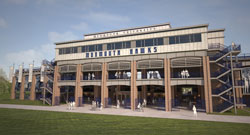The University recently announced plans to construct a new football field, Monmouth Stadium, for the fall 2015 semester. The stadium will host football games, lacrosse games, as well as men’s and women’s track and field events.
“The Monmouth Stadium has been in need of an upgrade for quite some time,” University President, Dr. Paul Brown, said. “…The upgrades are needed to meet the needs for our entry into the Big South for football as well as our entry into the MAAC (Metro Atlantic Athletic Conference) for lacrosse and outdoor track and field.”
The stadium construction will take a total of six months, although the University must first obtain approval from the borough of West Long Branch’s local zoning board. The new stadium will include many high-end features such as a full concession stand, permanent restrooms, a ticket sales window, chair-back seating, and a multimedia center. The arena will comfortably seat 4,000 fans and will also include a second floor reception area for season ticket holders.
After reviewing the upgrades to the stadium, head football coach, Kevin Callahan, believes the building is exactly what the fans deserve. “I think what it will do, most importantly, is provide a very first class venue for the campus community and people from the surrounding communities to come and watch football, lacrosse games and track meets,” Callahan said. “We have a tremendous facility in the MAC (Multi-Purpose Activity Center) and what I think will happen with Monmouth Stadium is it will provide a similar facility for football, lacrosse and track.”
Currently, the football team and both lacrosse programs play on Kessler Field, which was built in 1993. The field’s capacity is 4,000 people, similar to what is expected with the new stadium. However, the University’s Athletics Director, Dr. Marilyn
McNeil, strongly believes that the quality of seating will improve upon the arrival of Monmouth Stadium.
McNeil hopes the stadium will provide a proper student section so they will no longer have to be pushed against the railings below the bleachers or have to sit next to the opposing teams’ fans.
“The new facility basically ensures that everyone who comes to the game will get a decent seat. The students I have heard from have always said, ‘It is difficult for us to go there because there is no place for us, there’s no student seating section.’ [Kessler Field] is a stadium that doesn’t work for all the interested parties,” McNeil said.
McNeil also believes that this new stadium will be a profound statement by the University towards other Big South competitors. “Did the Big South entry spur it on? It made it a lot more relevant and gave a lot more urgency to it because we are going into facilities that are definitely better than ours,” McNeil said.
Callahan also agreed the stadium will bring the University to an even stature with Big South competitors in an appearance level, but he also believes that more student athletes will be inclined to choose the University as their school of preference.
“It definitely will increase [the amount of potential student-athletes]. One of the key things in recruiting is the type of facilities you have,” Callahan said. “That’s something every recruit looks at and evaluates as they go from one campus to another. In many cases, it is the determining factor on whether or not they select your school.”
Although the Athletics Department has made it known that construction will take approximately six months to complete, they have also announced that as of now, the funds needed to make the stadium possible have not yet been raised. The project in its entirety will cost $15 million, according to the Athletics Department. 25 percent of the cost has been pledged by the University itself while the other 75 percent must come from private funding. This means $11 million will have to be privately raised.
Brown said, “We have a budget for campus improvements in order to maintain an attractive and up-to-date campus environment. The Monmouth Stadium has been in need of an upgrade for quite some time.” He added, “… the upgrades are needed to meet the needs for our entry into the Big South for football as well as our entry into the MAAC for lacrosse and outdoor track and field.”
McNeil disclosed that the Plangere Foundation has already pledged $3 million towards the Monmouth Stadium and the project is currently gathering another $1 million from various supporters.
“Everybody is positive that we will find the funds sometime in the next three to four months,” McNeil said. “It really is dependent on the fundraising.”
Athletics is anticipating Monmouth Stadium to begin construction after the final 2014 football game and will be finished in time for the beginning of the 2015 football season. While this is the goal, the finish date is not yet definite.
Once both requirements are met, Coach Callahan believes that the University’s dedication to the project will increase its integrity.
“We had an opportunity this fall to see the facility at Liberty, we played at Coastal Carolina a few years ago and there is no question they have first rate facilities,” Callahan said. “I think that building a similar facility here at Monmouth will not only demonstrate our level of commitment but will put us on par with Big South football.”
PHOTO COURTESY of Ewing Cole Construction



